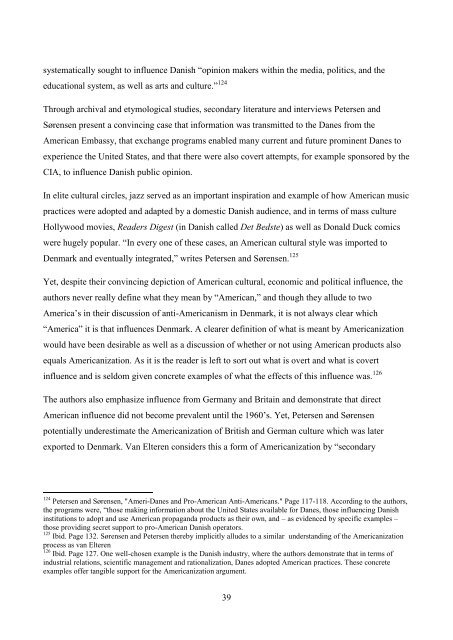The Jeremiad Over Journalism
The Jeremiad Over Journalism
The Jeremiad Over Journalism
Create successful ePaper yourself
Turn your PDF publications into a flip-book with our unique Google optimized e-Paper software.
systematically sought to influence Danish ―opinion makers within the media, politics, and the<br />
educational system, as well as arts and culture.‖ 124<br />
Through archival and etymological studies, secondary literature and interviews Petersen and<br />
Sørensen present a convincing case that information was transmitted to the Danes from the<br />
American Embassy, that exchange programs enabled many current and future prominent Danes to<br />
experience the United States, and that there were also covert attempts, for example sponsored by the<br />
CIA, to influence Danish public opinion.<br />
In elite cultural circles, jazz served as an important inspiration and example of how American music<br />
practices were adopted and adapted by a domestic Danish audience, and in terms of mass culture<br />
Hollywood movies, Readers Digest (in Danish called Det Bedste) as well as Donald Duck comics<br />
were hugely popular. ―In every one of these cases, an American cultural style was imported to<br />
Denmark and eventually integrated,‖ writes Petersen and Sørensen. 125<br />
Yet, despite their convincing depiction of American cultural, economic and political influence, the<br />
authors never really define what they mean by ―American,‖ and though they allude to two<br />
America‘s in their discussion of anti-Americanism in Denmark, it is not always clear which<br />
―America‖ it is that influences Denmark. A clearer definition of what is meant by Americanization<br />
would have been desirable as well as a discussion of whether or not using American products also<br />
equals Americanization. As it is the reader is left to sort out what is overt and what is covert<br />
influence and is seldom given concrete examples of what the effects of this influence was. 126<br />
<strong>The</strong> authors also emphasize influence from Germany and Britain and demonstrate that direct<br />
American influence did not become prevalent until the 1960‘s. Yet, Petersen and Sørensen<br />
potentially underestimate the Americanization of British and German culture which was later<br />
exported to Denmark. Van Elteren considers this a form of Americanization by ―secondary<br />
124<br />
Petersen and Sørensen, "Ameri-Danes and Pro-American Anti-Americans." Page 117-118. According to the authors,<br />
the programs were, ―those making information about the United States available for Danes, those influencing Danish<br />
institutions to adopt and use American propaganda products as their own, and – as evidenced by specific examples –<br />
those providing secret support to pro-American Danish operators.<br />
125<br />
Ibid. Page 132. Sørensen and Petersen thereby implicitly alludes to a similar understanding of the Americanization<br />
process as van Elteren<br />
126<br />
Ibid. Page 127. One well-chosen example is the Danish industry, where the authors demonstrate that in terms of<br />
industrial relations, scientific management and rationalization, Danes adopted American practices. <strong>The</strong>se concrete<br />
examples offer tangible support for the Americanization argument.<br />
39
















